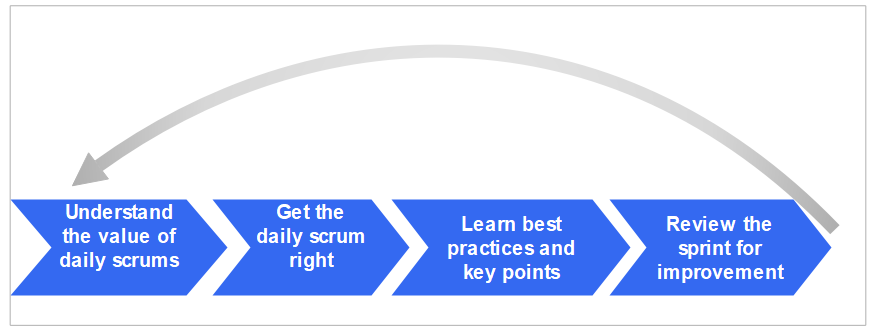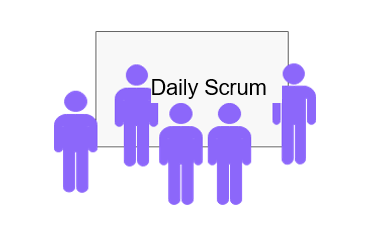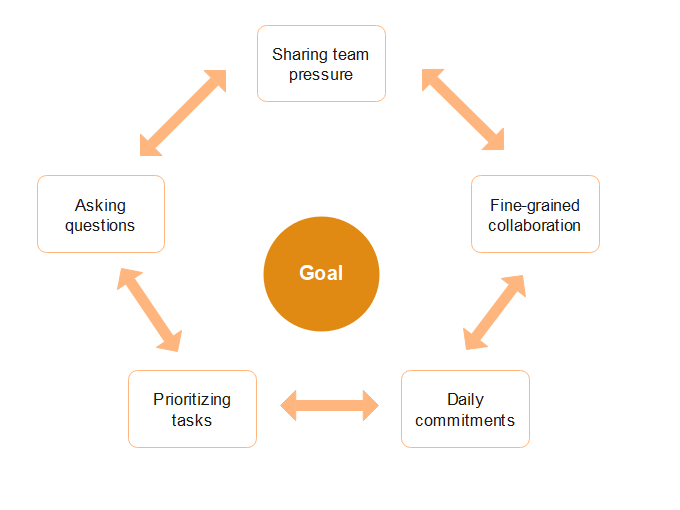Having Daily Scrums
Background
Some project teams of the enterprise meet daily, yet the outcome is not up to par. Daily scrums are much of a formality. Usually after a daily scrum, members go back to their individual tasks. They care only about their own work, and other team members do not understand their work at all. It seems that the daily scrum makes no difference.
How can we have a proper daily scrum? What is the point of it? Do we have to do it? Many teams have been struggling with these questions.
Problem Analysis
There are two scenarios for daily scrum questions.
- Scenario 1: The team understands the importance of the daily scrum but is unhappy with its current status. They want to make the most of the daily scrum. Teams like these struggle because they are not very clear about the core value of daily scrums and how to effectively conduct them. To have better daily scrums, these teams need some specific measures.
- Scenario 2: The team is trying to hold a daily scrum and does not know its value. It seems that there is no difference between having a daily scrum and not having one. In this case, the team has no understanding of daily scrums, not to mention any best practices and benefits.
To sum up, a deeper understanding of the value of the daily scrum, that is, why it is necessary and what it signifies, is needed in both scenarios. Then, you need to know how to have a good daily scrum. Finally, some best practices and key points are needed to help teams with a good daily scrum.
Solution
How can we have a good daily scrum? Take the following steps.

- Understanding the value of daily scrums
Daily scrum is a short meeting held on each day by a team that remains standing. It reviews daily work and make adjustment, and self-organizing in advance.
During the daily scrum, every team member can grasp the big picture, learn about what has happened recently, track the progress towards the sprint goal, assess if any adjustments are required for the day's tasks, and identify challenges or obstacles. A daily scrum is an activity that reviews, synchronizes, and adapts to daily plans to help self-organizing teams better do their work.
Some teams think that daily scrums are used to solve problems or report project progress to managers. However, their core significance and value are often misinterpreted.
Daily scrums help team members stay focused on their right tasks every day. Team members usually do not shirk responsibility because they make commitments in front of their coworkers. Team members are motivated to ensure they meet their daily goals. The daily scrum also ensures that the Scrum master and team members can promptly address problems, cultivate team culture, and make everyone feel the team spirit. Some organizations that do not use agile methodologies sometimes do daily scrums.
The value, significance, and misunderstandings of daily scrums are summarized as follows.
Figure 2 Benefits and misunderstandings
- Getting the daily scrum right
How can we have a proper daily scrum?
Team members gather around the whiteboard on time (to increase the sense of ceremony) to plan their daily tasks.
Figure 3 Daily scrum illustration
Team members need to take turns speaking and answer the following three questions during the daily scrum:
- What did I do yesterday? (What have I done since the last daily scrum?)
- What do l plan to do today? (What will I do before the next daily scrum?)
- What problems and obstacles have I encountered? (What problems and obstacles have hindered or slowed my work?)
These three simple questions can prompt team members to review their work daily, create their own work plans, seek assistance in overcoming obstacles, and make commitments to the team. If the team does the daily scrum properly, they can achieve the following outcomes.
Figure 4 Daily scrum goals
- Sharing team pressure
Healthy agile teams are under pressure to work together. All team members promised to work together to finish the sprint work. Therefore, team members are interdependent and accountable to each other. Team members cannot ignore some other member doing the same thing for many days without any progress and motivation to move forward. Their unfinished work will be an obstacle for other team members.
- Fine-grained collaboration
In daily scrums, team members should communicate efficiently with clear purposes. For example, if a member shares their plan for the day, another member can say, "Oh, so you are planning to do that today. I will need to rearrange my work priority. That is fine. Go ahead with your plan, I will make the necessary adjustments. I am glad you said that." This fine-grained collaboration allows team members to know how and when to collaborate with one another. An agile team should strive for higher efficiency and zero waiting time.
- Prioritizing tasks
In the daily scrum, every team member can stay updated on the ongoing and completed tasks. A healthy team needs to prioritize finishing tasks instead of constantly having tasks in progress. In the daily scrum, the team needs to prioritize their tasks so that they can focus on finishing these tasks as soon as possible. In other words, getting 10 things done is far more meaningful than doing 100 things.
- Daily commitments
At the daily scrum, team members need to make commitments to the team. In this way, team members know what will be delivered agilely and how to be accountable to one another.
- Asking questions
Problems can be raised at any time in Agile, but daily scrum is a golden time for team members to reflect on "what hinders me or slows down my work".
- Learning best practices and key points
Summarize some key points for successful daily scrums through a large number of practices. Maybe these key points are not fully applicable. Therefore, it is essential to customize these points to suit the specific circumstances. These key points are called "18 keys for daily scrums".
The "18 keys for daily scrums" are divided into people, procedures and methods, and tools and equipment to help you learn and memorize.
Figure 5 18 keys for daily scrums
- Key 1: Host
The host (such as the Scrum master) holds a meeting on time and manages the meeting duration. Team members can talk to each other concisely. They can take turns hosting the meeting to feel the pace of the meeting.
- Key 2: Two pizza-sized teams
In Succeeding with Agile: Software Development Using Scrum by Mike Cohn, a good way to determine the team size is to see if two pizzas can feed everyone on the team.
Because two pizza–sized teams are similar to the size of the family, the goal of the daily scrum can be easily achieved. When the team is a family size, it is easy to track what happens in the team. People can easily remember everyone's daily commitment and their responsibility for the team. It is also recommended to keep the team size small in Scrum, usually 7 to 9 people.
Finally, the team does not have to do daily scrums based on the above 18 keys. These keys are simply a collection of experiences and solutions to various problems. Each team may need to choose 18 keys according to their own needs.
- Key 3: Restricting speech
Non-team members are welcome to join, but they are not allowed to speak. During the daily scrum, only team members who are fully committed to reaching the sprint goal should talk.
- Key 4: Reserved buffer time
The development team should consider having a daily scrum either 30 minutes or 1 hour after their work hours start. This leaves some buffer time for regular tasks, such as checking emails. It can also give the development team extra time to review the work from the day before, such as defect reports generated by automated testing tools that were initiated overnight.
- Key 5: Same time and place
Daily scrums ideally take place at the same time and place, with a visualized task board in front of team members. By meeting regularly at a fixed time and place, team members can develop the habit, saving time and efforts to find a meeting spot or confirm schedules.
- Key 6: On-time start
All team members should arrive on time. The host should start the meeting on time, even if someone has not arrived yet. Latecomers should be punished, such as paying fines or doing push-ups. Team members decide on the penalties beforehand. If the penalty is a fine, the team also decides on how to use it. What if team members keep being late? For more solutions, see Learn More: Solutions for Members Being Late.
- Key 7: Stand-up meetings
Team members must stand for a meeting, which is why the meeting is called a daily scrum. Standing at a meeting is more efficient than sitting, encouraging people to wrap up the meeting sooner and get started on their work for the day. Sitting down is easy to relax, but difficult to stay focused and manage time effectively.
- Key 8: Emphasizing the purpose of daily scrums
The purpose of the daily scrum is often emphasized, especially for teams new to daily scrums. The Scrum master or other leaders (or meeting hosts) can emphasize the purpose of daily scrums. They gather feedback from team members about the daily scrum and the progress they have made. Over time, team members might decide to use the goal statement as their daily benchmark. Following each daily scrum, team members assess their own performance. It is an effective self-management tool.
- Key 9: Focusing on three problems
During the daily scrum, team members only focus on three topics (yesterday... today... the problems are ...) and do not talk about other things. Only discuss work that has been finished and is about to start, and any problems and challenges faced during that work. The purpose is not to report work to leaders, but to communicate with each other to understand the project progress and solve problems together.
- Key 10: Eye contact
It is a fun game in which someone is asked to speak in front of the group, and other members are asked to maintain eye contact with the speaker. The speaker will see who is looking away as they speak. This game keeps speeches concise and improves members' understanding of what speakers say, thereby accelerating the improvement of the daily schedule.
- Key 11: Strict timeboxing
The daily scrum is a 15-minute timebox for the development team. It is recommended that the meeting not be too long. For a team of 5 to 9 members, a meeting of 15 minutes is enough.
- Key 12: Post-meeting discussion
When someone is speaking, other members should listen carefully. They can ask concise questions for clarification, but they should not have lengthy discussions. To learn more about a member's report or seek assistance from other members, they are free to gather interested individuals for a discussion right after the daily scrum.
- Key 13: Problem and risk tracking
A brief record of the problems and risks encountered by the meeting members shall be made (avoid too many details), and saved to the knowledge base or somewhere appropriate. The purpose is to ensure that these problems and risks are closed (For example, problems and risks can be discussed and tracked after the meeting until they are closed).
- Key 14: Review and improvement
The daily scrum is a basic Plan-Do-Check-Act (PDCA). Also, the team can get feedback of the daily scrum during the retrospective meeting, including its pros and cons for the next sprint. (The daily scrum serves as a review point during the review meeting. If everything is going smoothly, no additional review is necessary.)
- Key 15: Speech stick
Some small props can be used to ensure that the meeting does not time out. I will find either a pen or a small item as a speech stick, ask a member to answer the three questions, and then pass it on to the next member. Only members with the speech stick can talk. If someone takes too long, interrupt in time and ask for the speech stick to be passed on to the next person.
- Key 16: Sprint backlog
In a daily scrum, team members can refer to the sprint backlog to check the task progress. The sprint backlog records the progress of team members' work and needs to be updated and tracked daily. The electronic sprint backlog can keep local and remote teams on the same page during daily scrums. When the speaker answers the three questions, the sprint backlog can be displayed to the team.
The CodeArts sprint backlog is as follows.
Figure 6 CodeArts sprint backlog
- Key 17: Task dashboard
In the daily scrum, the task board helps the team members to stay updated on the ongoing and completed work. The team prioritizes finishing tasks that are ongoing. By highlighting these tasks, the team can resolve them promptly.
- Key 18: Burndown chart
The burndown chart is a powerful tool for visualizing progress and remaining work. Generally, the vertical axis indicates the remaining workload (hours, story points, or number of work items), and the horizontal axis indicates the sprint duration (usually in days).
Figure 7 Burndown chart
Speakers can use a burndown chart to explain the progress during the daily scrum. The burndown chart enables all team members to see the sprint progress at a glance, including whether the work is on track and in good condition. The progress assists the team in figuring out if they can finish a set number of tasks and decide early in the sprint. The following effects can be achieved by using the burndown chart:
- High visibility, displaying progress and remaining work intuitively
- Rapid risk identification
- Helping the team develop knowledge and understand their strengths
- Knowing the work pace of team members
- Understanding the team sprint plan
- Using together with task walls for better efficiency
You do not have to use all 18 keys in a daily scrum. These keys are just suggestions based on successful practices. If you face problems during the daily scrum, consider the 18 keys and choose keys that fit your team. For example, there are four keys about tools. Do we need to use all these tools? No. As mentioned in the Agile Manifesto, individuals and interactions are higher than processes and tools. Tools serve the team, instead of weighing them down or even holding them back. Therefore, it is important for the team to choose the right keys.
- Key 1: Host
Learn More: Solutions for Members Being Late
Team members can discuss reasons for lateness at the retrospective meeting, gather opinions, or change the start time of the daily scrum. For example, why does the meeting need to start at 9:00 a.m? Can we do another time? What are the difficulties? They can work together to find a solution.
Emphasize the significance of team members arriving on time. The host should start the meeting at the scheduled time and place, even if some attendees are missing. Do not convey the meeting content again to latecomers. Otherwise, someone would think it acceptable to be late.
There should be some punishments for those who are late. The team members decide on the punishments beforehand. Compared with the rules given by others, you are more willing to follow your own rules and keep your commitments.
If the punishment is not enforceable, visualize the punishment. For example, make a specific spot on the whiteboard and pin a photo each time you are late. This particular spot attracts people to see.
Talk to those who are often late, try to understand what problems and difficulties they have, care about them, and help them solve the problems together.
If tardiness is prevalent, the team may not be able to solve the problem. You can attempt to enforce the company's policies and strictly follow the attendance system. However, this goes against the concept of agile self-management and cannot really solve the problem.
To sum up, consider the following factors when addressing the problem of tardiness:
- Analyze the cause, care about the members, and decide together.
- Do the daily scrum at a fixed time and place, and on time.
- If someone is late, do not convey meeting content again.
- Establish a mechanism for light punishment.
- Understand the reason for being late and whether there are difficulties.
Feedback
Was this page helpful?
Provide feedbackThank you very much for your feedback. We will continue working to improve the documentation.See the reply and handling status in My Cloud VOC.
For any further questions, feel free to contact us through the chatbot.
Chatbot





